Crypto day trading is a hugely popular market. Billions of dollars worth of crypto changes hands daily. There are thousands of trading pairs to choose from, each offering 24/7 access. However, most day traders lose money – especially when trading the speculative and volatile crypto markets.
In this guide, we explain everything beginners need to know before getting started. We cover the basics of crypto day trading, what strategies and risks to consider, and which platforms offer the best experience. Read on to get your crypto trading activities off to a flying start.
At its core, crypto day trading is a short-term strategy. It involves buying and selling crypto pairs to make quick but frequent gains. Similar to the traditional day trading markets, positions typically remain open for several hours. Some trades last for minutes, especially when opting for a scalping strategy. Either way, crypto day trading positions are never kept open overnight. The crypto day trading markets have grown to significant heights in recent years. At its peak, the total market capitalization of all cryptocurrencies was $2.5 trillion. On a daily basis, trading volumes average $50-100 billion. This means the crypto markets are highly liquid. Another benefit is that traders can day trade crypto 24 hours per day, 7 days per week. This means unlike stocks, commodities, and other traditional markets – crypto never sleeps. There are thousands of crypto pairs to choose from when day trading. Some traders prefer mega-caps like Bitcoin and Ethereum. Others target smaller cap projects with high-growth potential, such as Sui, dogwifhat, and Arbitrum. Some day traders have an even higher tolerance for risk. This means they day trade micro and nano-cap cryptocurrencies. As a beginner, it’s best to stick with the market leaders, as liquidity is higher, volatility is lower, and spreads are tighter. You can then explore more volatile markets as you increase your crypto day trading skills. Before getting started, it’s crucial to learn a suitable strategy and become proficient in crypto risk trading management.Introduction to Crypto Day Trading
Understanding the Basics of Day Trading Crypto
There are many important terms and concepts to learn when day trading crypto for the first time. We’ll now guide you through the basics. This will ensure your day trading career gets off to the best start possible.
Speculating on Crypto Trading Pairs
In a nutshell, crypto day trading involves speculating on short-term price movements. This means assessing whether a crypto pair will rise or fall in value. Speculating correctly means you’ll make money.
- Most day traders opt for USDT pairs. This is a large-cap stablecoin that’s pegged to the US dollar.
- So, if Bitcoin is valued at $65,000, BTC/USDT will also trade for $65,000 (give or take a few basis points).
However, more experienced crypto day traders will also speculate on cross-pairs. These are trading pairs that contain two competing cryptocurrencies, such as BTC/XRP or SOL/ETH. Crypto crosses are best left until you’re comfortable with the basics.
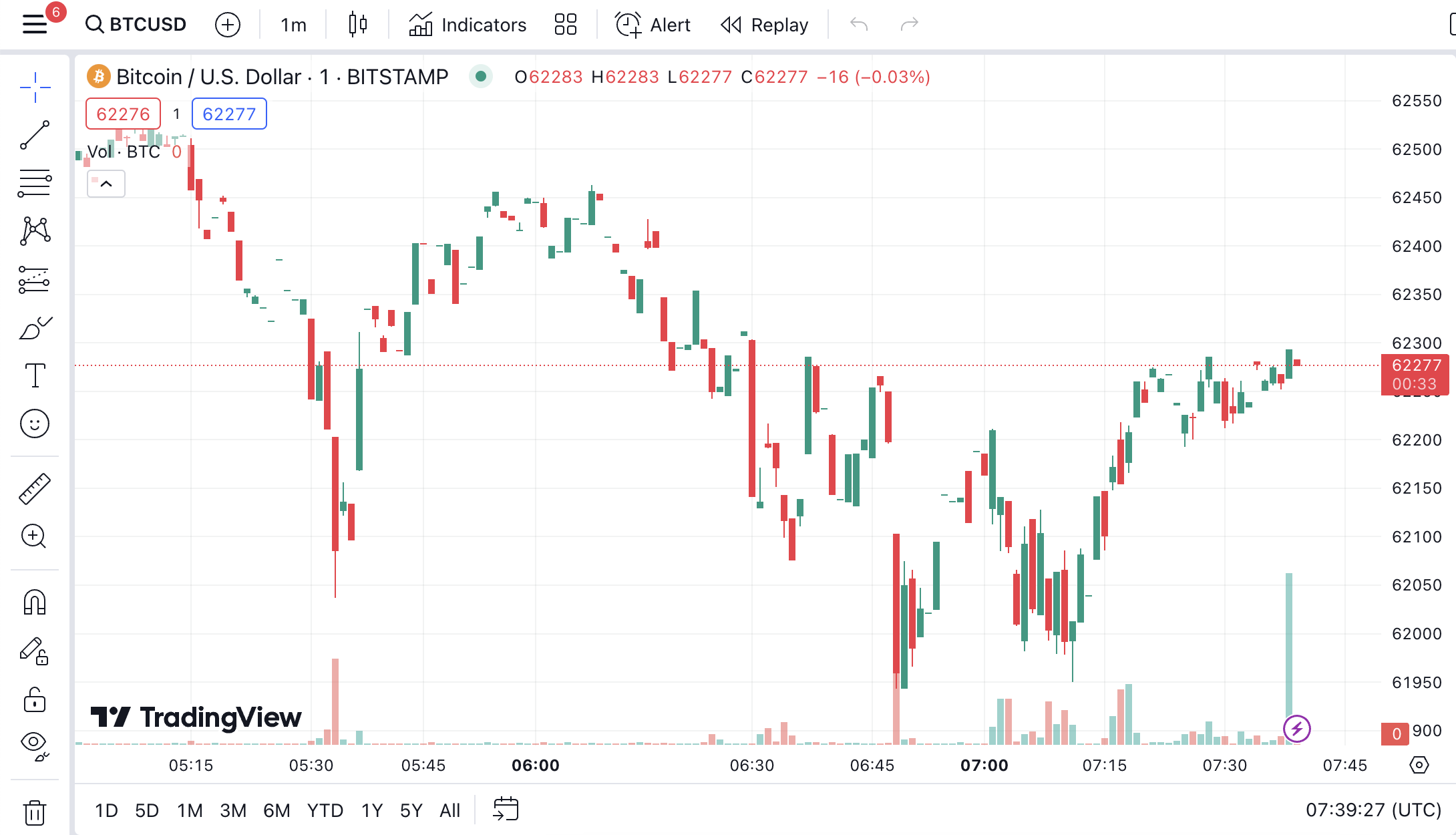
Nonetheless, there are thousands of pairs to choose from, meaning day traders always have access to market opportunities. This ranges from mega-caps like Bitcoin to newly launched nano-caps. The risk spectrum increases as the market capitalization gets smaller.
Long and Short Crypto Trading
Traditional investing requires traders to buy a crypto and hope its value increases. Day trading also supports long investing. However, day traders also have the option of going short.
Here’s what you need to know:
- Long (Buy): Crypto day traders go long when they believe the market price will increase. This requires a buy order when executing the position. Closing the position requires a sell order.
- Short (Sell): Going short means day traders believe the market price will decline. Entering the market requires a sell order. While closing the position needs a buy order.
Do note that the only way to short-sell crypto is by trading derivatives. The most popular derivatives used by crypto day traders are ‘perpetual futures’. These are similar to traditional futures contracts but they don’t have an expiry date.
What’s more, perpetual futures support leverage – a crucial tool for crypto day trading. We talk about derivatives in more detail later. You can also check out our beginner’s guide: What is Crypto Futures Trading?
Before continuing this guide on crypto day trading let’s look at a quick example:Quick Example of Crypto Day Trading
Leveraged to Increase Day Trading Margins
We’ve established that most crypto day trading positions are kept open for several hours or minutes. And never more than a day. As such, day traders often make small profit margins – especially when trading large-cap cryptocurrencies like Bitcoin and Ethereum. Sure, large caps are still volatile, but prices often only move by a few percentage points each day.
This means profit margins are often thin when day trading. While this might not be an issue for those with large capital balances, it will be for day traders on a budget.
- For example, suppose you’re prepared to risk $500 per day trading position.
- You make 2% gains on the first day.
- This means that before fees and commissions, you’ve made $10.
This likely won’t be enough to make the crypto day trading process worthwhile. This is especially the case considering how much research and analysis is needed. With this in mind, many day traders use leverage when entering positions. This amplifies the position size by a certain multiple. For example, if you’re risking $500 with leverage of 10x, you’re trading with $5,000.
On the one hand, leverage is ideal if you have limited funds to day trade. Some crypto exchanges offer leverage of 100x and more. However, leverage is also risky. Leveraged positions can be liquidated if they decline by a certain amount. This means that the day trading position will be closed and the exchange will keep the original stake.
Day Trading Instruments
There are many different ways to day trade crypto. The most common way is to buy and sell coins on the spot trading markets. This means you initially purchase and own the underlying coins. For example, suppose you’re trading LTC/USDT. Placing a long order means you’ve bought Litecoin with Tether. When you close the position, you’re buying Tether with Litecoin.
That said, experienced crypto day traders will use more exotic financial instruments. For example, perpetual futures contracts are increasingly becoming popular. In fact, these come with several benefits that can’t be found when using the spot trading markets. For a start, perpetual futures support long and short selling – simply choose between a buy or sell order.
In addition, perpetual futures come with leverage. Another benefit is that perpetual futures never expire. This offers greater flexibility. It’s also possible to day trade delivery futures. Unlike perpetuals, these come with a settlement date – which is often monthly or quarterly. Some crypto day trading platforms also support options. These are great for making high-risk plays without needing to risk too much money.
This is because crypto options only require a ‘premium’ upfront. Depending on the strike price, this might only be 10% of the overall position size. And, if the crypto options trade doesn’t yield a profit – only the premium is lost. Another way to day trade crypto is via contracts-for-differences (CFDs). These are offered by regulated brokers like AvaTrade.
Put simply, CFDs track crypto prices in real-time. So, if DOGE/USD increases by 2%, so will the CFD instrument. Crypto CFDs support long and short trading, not to mention leverage. What’s more, AvaTrade offers 0% commissions when trading crypto CFDs. That said, crypto CFDs aren’t available in all countries, including the US and the UK.
Managing Risk in Day Trading Crypto
It goes without saying that crypto day trading is a high-risk marketplace. The simple fact is that most traders lose money – especially beginners. The reason is that newbies often fail to implement a risk-management plan.
Let’s take a closer look at how crypto day traders can mitigate risk without hindering profit potential.
Bankroll Management
Before placing any day trading positions, it’s crucial to craft a bankroll management plan. This will ensure your trading balance – no matter how big or small, it is protected from extended losing runs. Put otherwise, bankroll management ensures your balance doesn’t drop to zero. Or worse – into negative territory (more on this later).
So how does bankroll management work when day trading crypto? In a nutshell, you’ll need to evaluate the maximum amount that can be risked on any single trade. This should be stated in percentage terms. There’s no rule of thumb here, although most day traders opt for between 1-3%.
- For example, suppose you opt for a 2% bankroll management strategy. Your trading balance is $5,000.
- This means the maximum day trading position size is $100 (2% of $5,000).
- The good news is that the maximum position size increases in line with the portfolio value.
- For instance, let’s say your trading balance has increased to $8,000.
- Your 2% bankroll management strategy means that the maximum position size is now $160.
Conversely, let’s say you’re struggling to find your feet in the crypto day trading space. Your trading balance has declined to $4,000. At 2%, the maximum trade size has been reduced to $80. As such, this reduces the rate at which your balance declines. Ultimately, stakes increase when you’re doing well, and decrease when the opposite happens.
Emotional Discipline
Another important part of risk management is emotional discipline. It’s crucial to recognize that even the most profitable crypto day traders make losses. It’s simply not possible to win 100% of trades. Naturally, beginners will likely encounter more losing positions than experienced pros.
This is to be expected. It’s how beginners deal with the emotional side effects of losing money. One of the biggest risks is that traders begin chasing losses. This means increasing position sizes and thus – breaking bankroll management limits. This is a recipe for disaster.
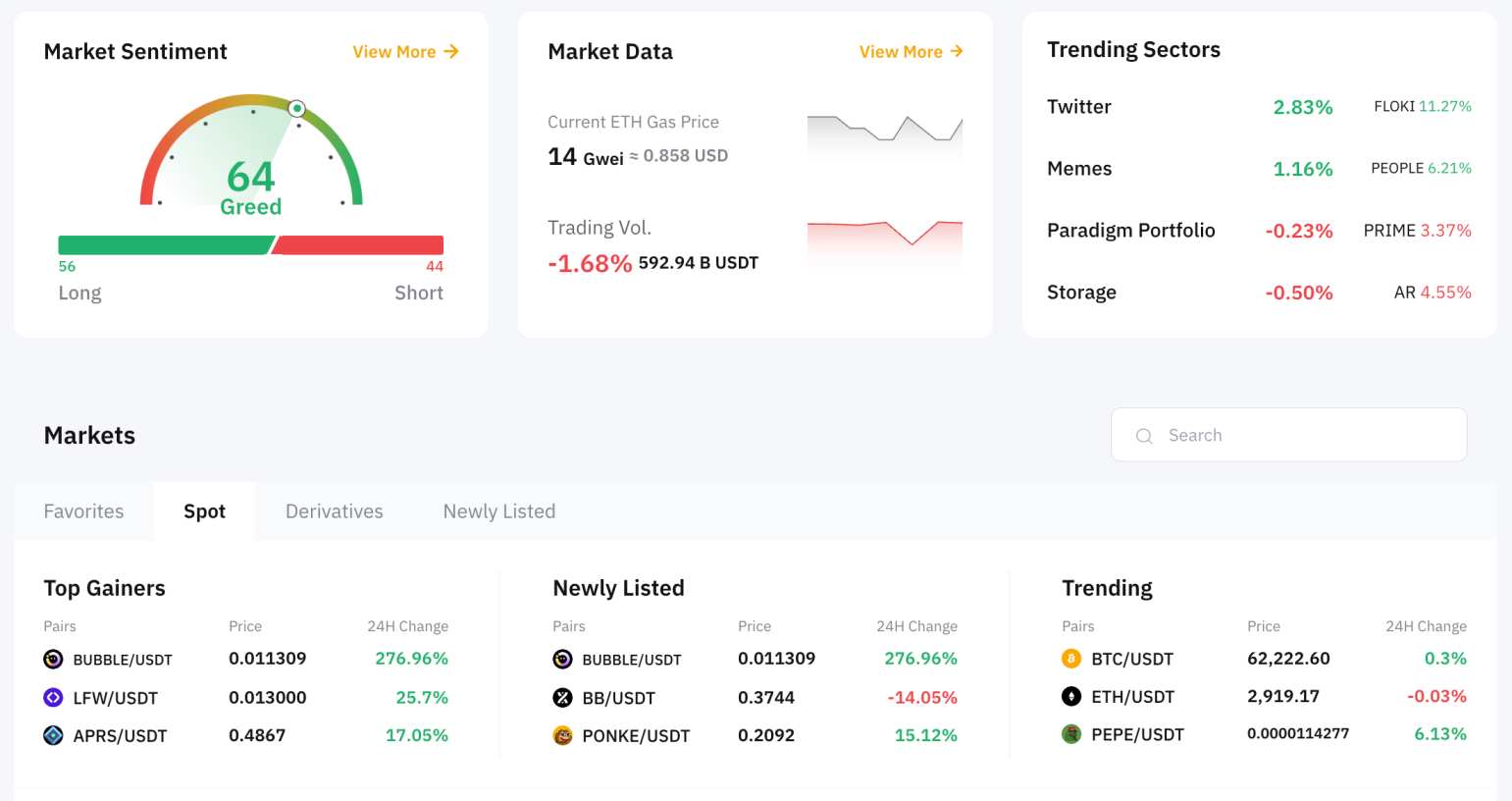
As such, before getting started with crypto day trading, make sure you’re preferred for losses. Avoid making trading decisions based on emotions. This means never becoming emotionally attached to a specific coin or token. It’s always best to cut your losses at the right time, rather than hoping for a reveal.
Risk Management Orders
Although it can take time to navigate trading emotions, risk management orders will help you get there a lot faster. The most important risk management order is a stop-loss. These instruct the trading platform to close a position when it declines to a certain price. This prevents losses from getting out of hand.
The best way to enter stop-loss order prices is by the percentage amount.
- For example, suppose you enter a long position at $100 per coin.
- You want to limit your potential losses to 5% of the position size.
- This means the position will be closed if the coin declines by 5% – so the stop-loss order should be set at $95.
- If you’re going short on the coin, the stop-loss order should be set at $105.
Once the stop-loss price is met, the exchanger will close the order automatically. However, do note that in ultra-volatile markets, stop-loss orders won’t always be executed at the stated price. Although this is rare, it’s something to be aware of.
Nonetheless, we’d also suggest entering take-profit orders. These also play an integral role in crypto risk management. Take-profit orders will close a profitable position when the target profit has been met.
- For example, suppose you’re going long on a $200 coin. You want to make a 20% profit.
- In this instance, the take-profit order should be set at $240.
- So, if the coin increases to $240, the exchange will automatically close the position.
- This means your 20% profit has been secured, no matter what happens moving forward.
It’s also worth considering a trailing take-profit order. This is a great way to keep profitable positions open for as long as possible, while still securing some gains. This is because trailing take-profit orders automatically adjust based on price movements. Ultimately, trailing take-profit orders allow you to ride profitable trades for as long as possible. While at the same time, the exit price is constantly being adjusted, meaning you’ll still make a profit if the market suddenly changes direction.Trailing Take Profit Orders
Avoid Overtrading
Another common pitfall made by crypto day trading beginners is overtrading. This often links back to trading on emotions. For instance, the excitement and volatility of crypto can mean that traders place too many orders. This is especially the case when the broader markets are bullish.
Similarly, overtrading can also happen when traders witness losses. There can be a tendency to enter more positions to try and recover these losses – which is a huge risk. It’s perfectly fine to have days where you don’t open any positions.
Rather, avoid entering positions for the sake of it. Unless you have a high conviction on a particular coin or token, wait for a better opportunity to arrive. After all, not only are there thousands of pairs to trade – but the crypto markets never sleep.
The Importance of Developing Crypto Day Trading Strategies
Now that we’ve covered risk management, we can now talk about crypto day trading strategies. Put simply, without a strategy you won’t be able to make consistent gains.
What’s more, you must be proficient in the chosen strategy. This will ensure you’re ready for all market potentialities, whether that’s rising or falling trends.
This section explores some of the best strategies for day trading beginners.
Scalping Techniques for Quick Profits
While scalping is one of the lowest-risk crypto day trading strategies, it’s also one of the most difficult to master. Moreover, unlike the other strategies we’ll discuss, scalping is very time-intensive. Nonetheless, scalping aims to make quick profits by entering and existing positions at rapid intervals. While trades typically remain open for minutes, some run into the seconds.
The idea is to capitalize on second-by-second price movements.
- For instance, suppose you go short on BTC/USD.
- You enter the market at $62,500.
- Once BTC/USD drops to $62,300, you close the position.
- Before fees and commissions, you’ve made a small profit of 0.32%.
These are the kinds of profit margins made by scalpers. As such, there are some extra considerations to make.
First, unless you’ve got a 6-figure bankroll, leverage is crucial when scalping. Although this increases the risks, scalpers rely on stop-loss and take-profit orders. This means potential gains and losses are capped. Without leverage, or a sizable trading balance, scalping simply won’t be viable – considering the small margins targeted.
Second, as we cover in more detail later, you’ll need a firm understanding of technical analysis. This means making technical trading decisions based on key indicators, such as the MACD and RSI. Otherwise, there’s simply no way to know whether prices will rise or fall in the immediate term.
Third, scalping strategies will only succeed if you’re using a suitable trading platform. This means using a platform that charges minimal fees and tight spreads. This ensures that small profit margins are still profitable. For example, suppose your scalping position is up 0.7%. However, closing the trade will attract a 1% commission. This means the commission turns a profitable trade into a losing one.
Arbitrage Trading for Near-Risk-Free Gains
Arbitrage trading is also popular with crypto day traders. This strategy is considered near-risk-free, as traders take advantage of price discrepancies.
- For example, let’s say that you’re analyzing Litecoin.
- You notice that Litecoin is trading at $80.50 on Binance.
- However, on OKX, Litecoin is trading at $80.30.
- So, you purchase $10,000 worth of Litecoin on OKX at $80.30.
- You then sell that Litecoin on Binance at $80.50.
- This results in a small profit margin of 0.25%.
- On a $10,000 trade, that’s $25.
Although the arbitrage strategy is worth considering, there are some drawbacks. First, arbitrage trading isn’t risk-free. Prices change as every second passes. Meaning – you could be left with a loss after placing the initial order.
For instance, our example mentioned that you bought Litecoin at $80.30 on OKX. However, the price on Binance might have suddenly dropped below $80.30. This means the arbitrage is no longer profitable.
Moreover, crypto arbitrage trading is now dominated by bots. This is crucial, as bots can enter positions simultaneously in milliseconds. Repeating the same position manually will invariably take longer, meaning the arbitrage opportunity might have already been lost.
Momentum Trading: Riding the Waves of Market Trends
Another strategy to consider is momentum trading.
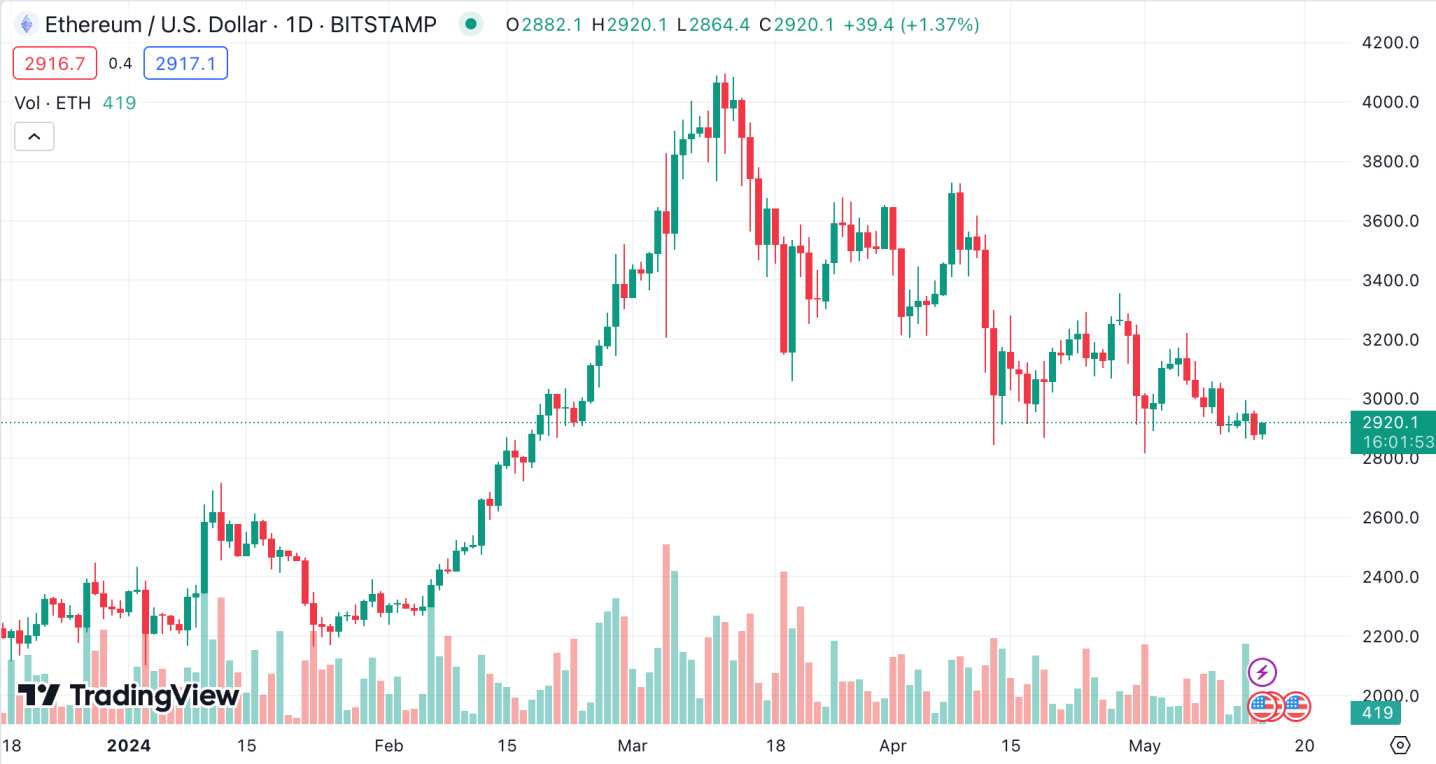
As the name suggests, you’ll be entering day trading positions based on price momentum.
- For example, suppose you’re trading ETH/USD on the 5-minute chart.
- You notice that for 10 straight candlestick movements, ETH/USD has increased.
- This represents strong price momentum, so you enter a long position.
- You also enter a stop-loss order just below the existing candlestick, in case a sudden market reversal occurs.
In terms of targets, trailing take-profit orders are ideal for momentum trading strategies. This means profitable positions remain open for as long as the momentum trend is in place.
Range Trading to Capitalize on Support and Resistance Levels
One of the best crypto day trading strategies to master is range trading. This requires traders to identify specific price ranges based on historical support and resistance levels.
- For example, suppose that Bitcoin has a strong support zone at $58,000. This means that whenever the Bitcoin price is falling, it rarely drops below $58,000. This is because buying pressure helps Bitcoin stay above this price level.
- At the same time, Bitcoin has a strong resistance zone at $61,000. This means during this pricing range, Bitcoin struggles to move above $61,000.
- Therefore, the identified pricing range is $58,000 to $61,000.
The next task is to enter some day trading orders.
- First, you’d want to enter a long order just above $58,000. You’d also want to enter a stop-loss order just below $58,000. This offers protection in case the support level is breached.
- Second, you’d want to enter a short order just below $61,000. A stop-loss order just above $61,000 should also be entered.
These orders allow you to capitalize on the identified range in a risk-averse manner.
Fundamental Trading: Enter Positions Based on News Developments
Those without any chart analysis experience might be better suited for a fundamental trading strategy. Although this strategy is more common with long-term investments, it can also be used for crypto day trading. Put simply, you’ll enter long or short orders based on real-time news. This means you’ll need to be kept abreast of key market developments whenever they break.
- For example, suppose the SEC announces that it will decline Ethereum ETF applications. This will likely result in ETH/USD declining. Therefore, you could enter a sell order on ETH/USD to capitalize on the news.
- Similarly, suppose China announces that it will allow its citizens to buy Bitcoin. This news is positive for Bitcoin, so BTC/USD will likely increase.
Although it’s relatively simple to assess whether news is positive or negative, fundamental trading strategies don’t always go to plan. This is also the case when trading traditional assets, such as stocks.
For example, even though news might be positive, this doesn’t guarantee that the respective coin will increase in value. And vice versa for negative news stories. Moreover, you’ll need to act quickly when reacting to crypto developments. This means entering positions in seconds, not minutes.
Technical Analysis Tools and Indicators for Crypto Day Trading
With the exception of fundamental strategies, technical analysis is a core requirement of crypto day trading. This is because day trading is about short-term trends – positions never remain open overnight. As such, the only way to determine whether prices will rise or fall is by studying pricing charts. In addition, day traders use technical indicators to discover trends.
While there are hundreds of technical indicators; the most successful day traders will choose the most appropriate ones for their preferred strategy. This means becoming an expert in selected indicators, rather than trying to master them all.
Some of the most commonly used indicators are summarized below:
- Relative Strength Index (RSI): The RSI evaluates the speed and velocity of short-term price movements to determine whether a crypto pair is over or underbought. The rule of thumb is that an RSI reading of over 70 illustrates overbought conditions, meaning the pair could decline in value. And vice versa if the RSI reading is below 30.
- Moving Average Convergence Divergence (MACD): The MACD is ideal for discovering buy or sell signals, based on two moving price averages. For example, the exponential moving averages of the 12 and 26-day lines. Traders can then make informed decisions about the short-term direction of the respective pair.
- Volume-to-Market Cap Ratio: The volume-to-market cap ratio is another use indicator – especially for short-sellers. If the 24-hour trading volume surpasses the coin’s market capitalization, this could highlight that it’s overbought. In turn, the coin’s price could be set for a strong reversal. This indicator is particularly helpful when trading speculative meme coins.
We’d suggest using a demo account when learning about technical analysis. Demo accounts usually mirror live crypto market conditions. This means you can perform analysis and place trades without risking any money.
The Importance of Choosing the Right Crypto Day Trading Platform
The focus up to this point has been on trading strategies and tactics. However, we’ve yet to discuss the importance of choosing a suitable crypto day trading platform.
Some of the core factors to consider include commissions, spreads, supported pairs, and order execution speeds. Not to mention leverage limits, trading instruments, and security.
This section explains these factors in more detail, ensuring you choose the right platform for day trading crypto.
Low Trading Fees
Day trading crypto with high fees will make the process unviable. After all, day trading strategies rely on small profit margins. Unfavorable fees can turn profitable positions into losing ones. As such, it’s crucial to choose a trading platform with competitive commissions and spreads.
Commissions are charged when entering and exiting positions.
- For example, Bybit charges 0.1% per slide when trading the spot markets.
- Suppose you enter a $400 long order. This means you’d pay a commission of $0.40.
- You close the position when it’s worth $500. At 0.1%, you’d pay a closing commission of $0.50.
Day traders should also evaluate the spread, which is the gap between the buy and sell prices. For instance, suppose the buy price is $100. The sell price is $102. The percentage difference, or spread, is 1.98%. This would constitute an unfavorable spread, as you’d need to make at least 1.98% just to break even. This is in addition to the trading commission.
Available Trading Pairs and Instruments
Crypto day trading platforms typically support various pairs. However, the specific pairs available will vary depending on the provider. Make sure the platform offers access to your preferred markets, such as Bitcoin, Dogecoin, or Litecoin. The more pairs the better, as you can concentrate all day trading positions on the same exchange.
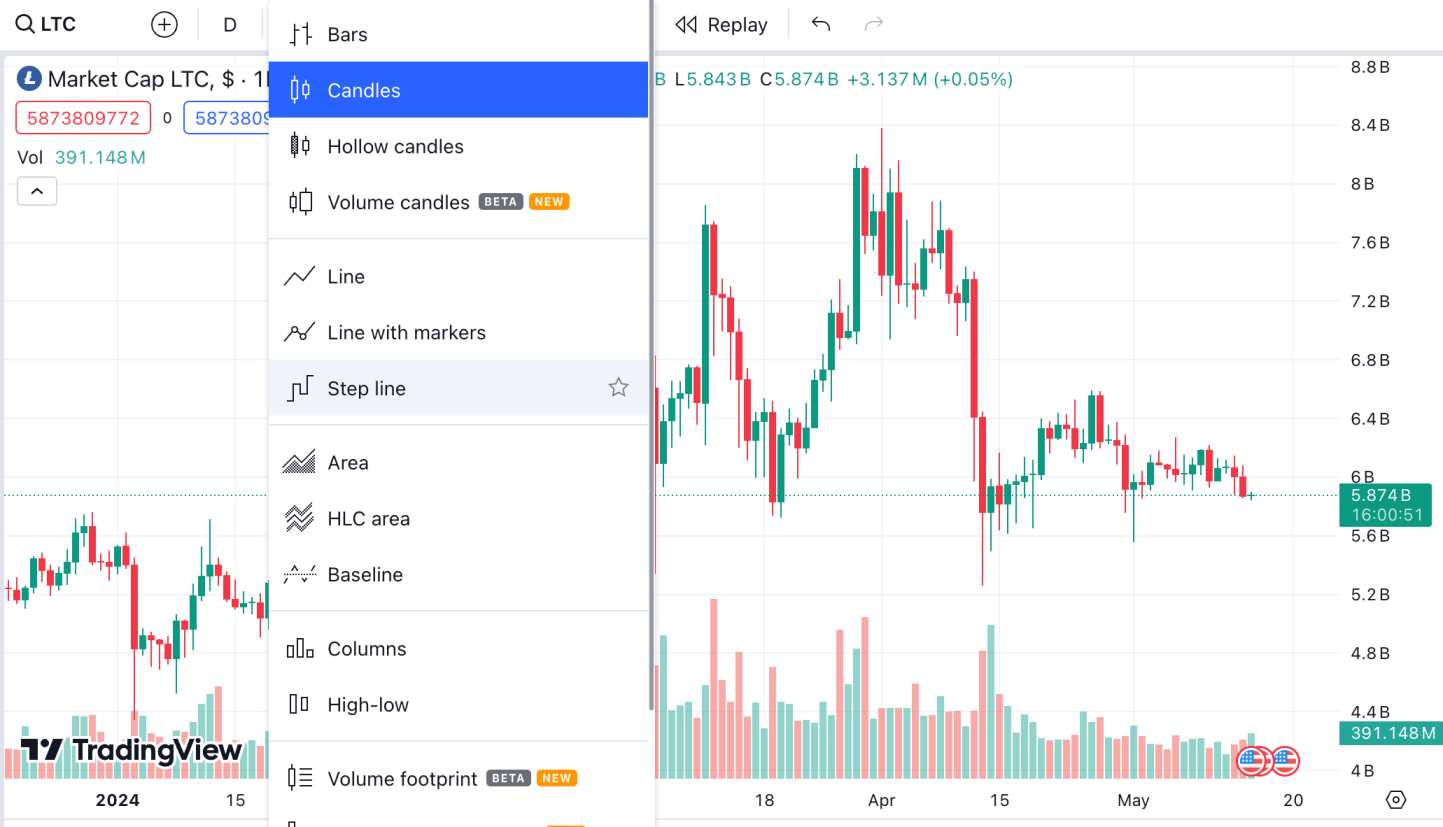
Otherwise, you’d need to keep swapping between platforms, which can be cumbersome. What’s more, you’ll need a platform that supports your preferred trading instruments. For example, you might want to trade the spot trading markets, which is more suitable for beginners. However, some platforms also offer options and perpetual futures. These are ideal for short-selling strategies and accessing leverage.
Sufficient Liquidity Levels
Day traders must use a trading platform that has sufficient liquidity levels. This ensures your buy and sell orders are executed at favorable prices. Without enough liquidity, increased volatility is a huge risk. For example, suppose you want to close a profitable position at $40 per coin.
This aligns with the current market price. However, due to low liquidity, you’re forced to close the trade at $39 per coin. This could be the difference between making a profit or a loss. With this in mind, it’s best to stick with high-volume platforms like Bybit and Binance.
Day Trading Tools and Leverage
We’ve established that crypto day traders require analysis tools, such as technical indicators and real-time news. It makes sense to choose a trading platform that offers these tools in-house. This increases efficiency, as you won’t need to switch between platforms.
Additionally, the platform should offer suitable leverage limits. This should align with your budget and risk tolerance. Always check what fees apply to leveraged positions, as this is in addition to commissions and spreads.
Reputation and Security
One of the main drawbacks of crypto day trading is the counterparty risks. This is because day traders need access to real-time liquidity, meaning trading capital is kept in an exchange account. This ensures traders can capitalize on opportunities instantly, rather than needing to make a deposit every time.
As such, it’s crucial to choose a trading platform that’s reputable and secure. At a minimum, there should be two-factor authentication. This means account access isn’t possible without first entering a code. The code is obtained from a mobile device that’s unique to the user.
The Best Platforms for Day Trading Crypto
If you don’t have time to research trading platforms independently, consider the providers listed below.
1. AvaTrade – Best Option for Day Trading Leveraged Crypto CFDs
AvaTrade is an established trading platform with a great reputation for safety and legitimacy. It holds licenses in nine different countries, including Ireland, Australia, Japan, and the UAE. AvaTrade specializes in crypto CFDs, meaning long and short orders are supported.
Not to mention leverage. What’s more, AvaTrade is a commission-free broker, making it ideal for crypto day trading strategies. AvaTrade supports the most popular crypto coins, tradable against USD. This includes Bitcoin, XRP, Solana, Dash, Chainlink, Ethereum, and Litecoin.

Day traders will also like that AvaTrade supports multiple trading platforms. This includes MT4 and MT5, plus a proprietary charting platform that’s unique to AvaTrade. Another benefit is that AvaTrade accepts multiple payment types, including debit/credit cards and e-wallets.
The minimum first-time deposit requirement is just $100. AvaTrade also supports other day trading assets, including commodities, forex, indices, and stocks. It also offers a native options trading suite, although this only covers major currencies.
Pros:
Cons:
2. Bybit – Best Option for Day Trading Perpetual Futures
Another top-rated platform for crypto day trading is Bybit. It supports hundreds of crypto pairs, making Bybit ideal for diversified strategies. This includes a broad range of large and small-cap markets, ensuring that all risk profiles are catered for.
We also like that Bybit supports multiple instrument types. This includes perpetual and delivery futures. These come with high leverage limits of up to 125x. This means traders can enter a $12,500 crypto position with just $100 in their account.
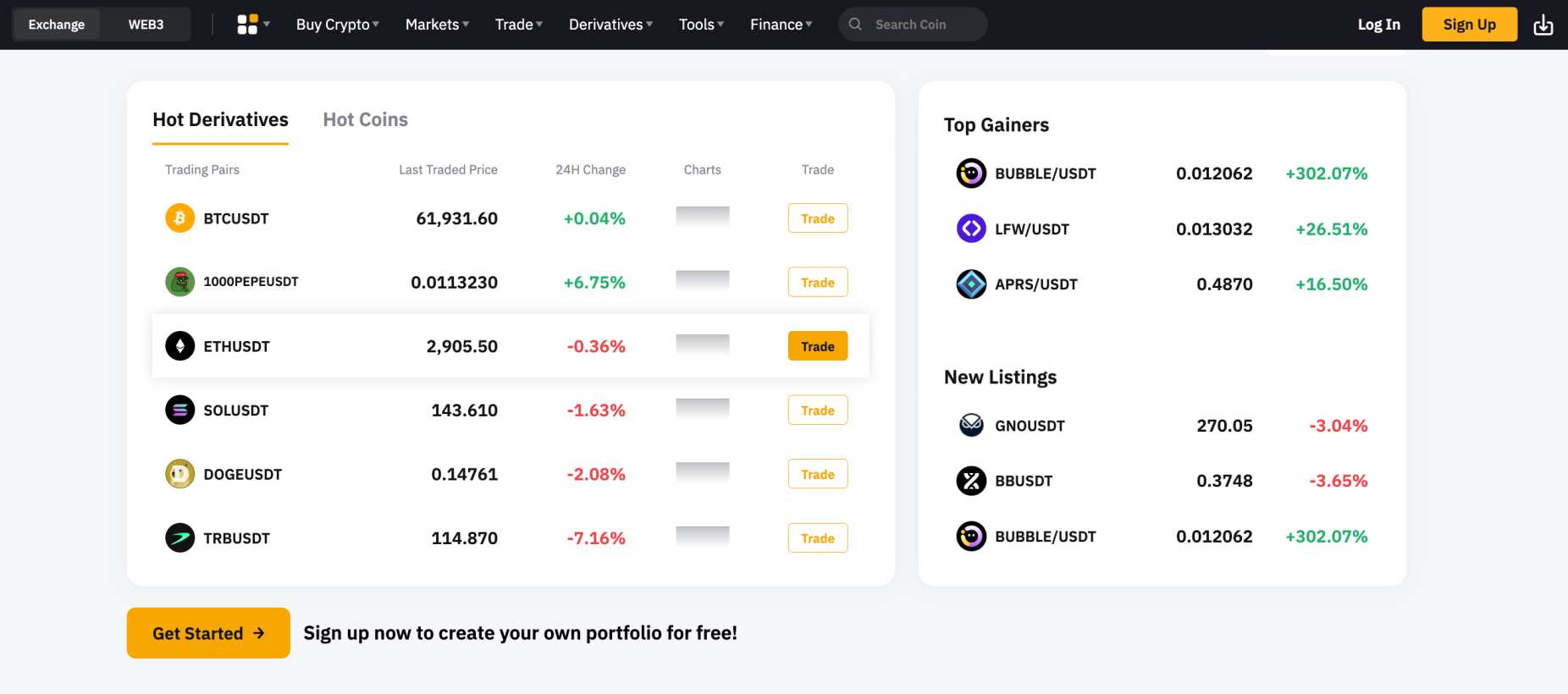
Bybit futures also make the short-selling process seamless, which is crucial when day trading crypto. All that said, Bybit also offers spot trading markets for those who aren’t interested in leveraged derivatives. Either way, the Bybit platform is integrated with TradingView, meaning it’s packed with tools.
This includes drawing tools, indicators, and customized trend lines. Bybit is also a great option for low trading fees. It charges a 0.1% commission when spot trading. Perpetual and delivery futures positions are charged 0.055% per slide. Lower fees are offered to VIP day traders.
Pros:
Cons:
While crypto day trading can be a lucrative market – the reality is simple. Most day traders lose money. Unless you’re prepared to spend countless months learning trading strategies, chart reading skills, technical indicators, risk management tactics, and more – then becoming a successful day trader will be challenging. This is unless you consider using an automated trading bot like Algobot. Algobot enables beginners to make day trading profits without learning the ropes of technical analysis. It’s a fully automated bot that buys and sells crypto pairs based on algorithmic signals. Algobot trades multiple time frames. This includes the 1-minute and 5-minute charts, which are crucial for day trading. Best of all, Algobot operates 24/7. This means you can day trade crypto around the clock, without needing to worry about trading emotions or fatigue. Algobot takes care of everything. Since testing began, Algobot has produced a win rate of over 82%.Algobot: Streamlining the Crypto Day Trading Process for Beginners
Conclusion: Mastering Crypto Day Trading for Long-Term Success
Becoming a successful crypto day trader requires time and patience. Proficiency in a proven strategy like scalping or momentum trading is imperative. You’ll also need to possess high-level chart reading skills and the ability to trade without emotions.
If you’re looking to fast-track the crypto day trading process, consider Algobot. Algobot automates the trading process, meaning it buys and sells cryptocurrencies on your behalf. It can be customized to suit your preferred risk profile, and no prior experience is needed.
FAQs
Is crypto good for day trading?
Yes, there are thousands of crypto markets that operate 24/7, making the industry ideal for day trading. Crypto is suitable for multiple strategies, including arbitrage, momentum trading, and scaling.
What is the best day trade crypto platform?
Bybit is a great option if you’re looking to day trade crypto futures, with the platform offering perpetual and settlement contracts. AvaTrade is a top pick for trading crypto CFDs at 0% commission.

